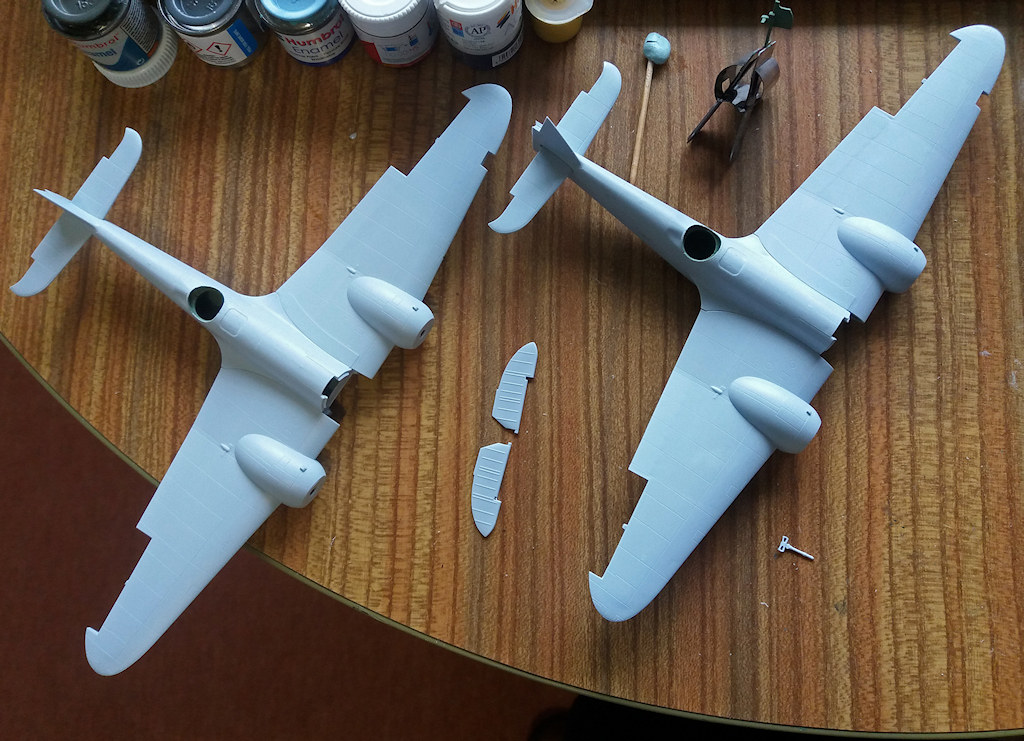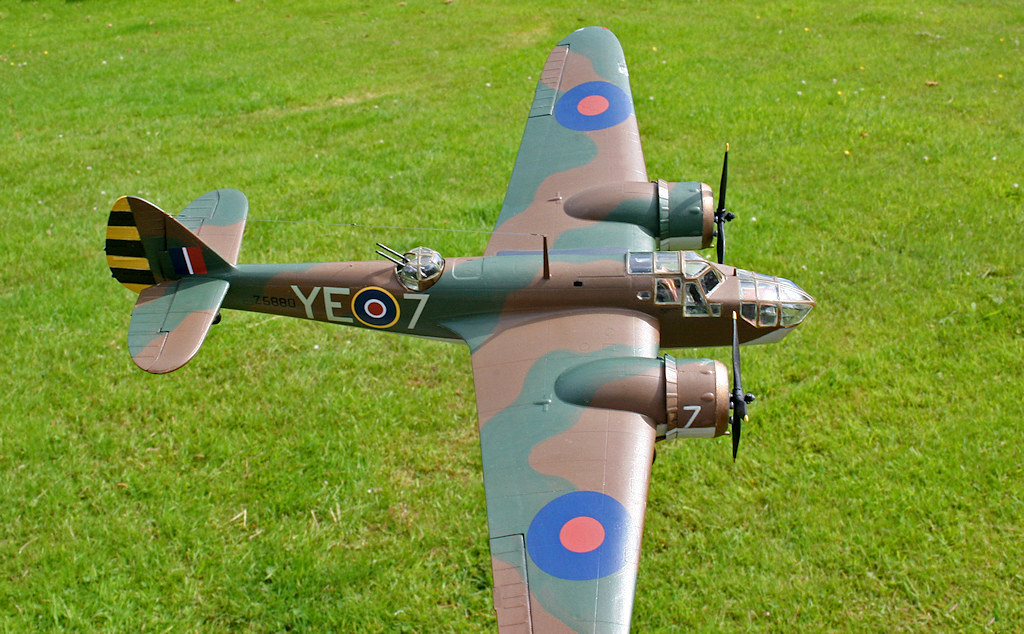|
|
Post by acklington on May 10, 2020 18:34:12 GMT 1
Bet that made you look!  I think that 'lockdown fever' has finally taken hold as I've just started another example of an aircraft/kit that I don't like, so the sooner they're done and finished the better.  Bristol Pair (1) w Bristol Pair (1) w by Philip Pain, on Flickr  Bristol Pair (2) w Bristol Pair (2) w by Philip Pain, on Flickr Occasional updates will follow ........... |
|
|
|
Post by acklington on May 13, 2020 20:08:45 GMT 1
Finished the cockpit interiors, and then had the nerve wracking job of adding the canopies. Clear transparencies and glue should be avoided!  Bristol Pair (3) w Bristol Pair (3) w by Philip Pain, on Flickr  Bristol Pair (4) w Bristol Pair (4) w by Philip Pain, on Flickr As can now be seen, one is a 1/72 Airfix Bristol Blenheim Mk.I, and the other a Blenheim Mk.IV |
|
|
|
Post by acklington on May 26, 2020 20:56:54 GMT 1
Slower progress than I would like, but the Mk.1 was first up on its wheels  Bristol Pair (5) w Bristol Pair (5) w by Philip Pain, on Flickr The Airfix kits come with flaps in the 'down' position, but can be made 'up' by removing the tabs. However having done that you discover that they don't fit very well at all, by which time it is too late to go back, and much effort is required to get a reasonable fit. So this is the Mk.1 with flaps 'up', but the Mk.IV I'll model them down, it's much less hassle  Bristol Pair (6) w Bristol Pair (6) w by Philip Pain, on Flickr Painting is finally well under way, and the Mk.1 will have the 'B' camo scheme as it had an odd number serial. The Mk.IV will be 'A' camo to go with its even number serial.  Bristol Pair (7) w Bristol Pair (7) w by Philip Pain, on Flickr Thanks again for looking |
|
|
|
Post by acklington on Jun 2, 2020 12:37:49 GMT 1
I gave up trying to build them both at once, and concentrated on getting the Mk.1 finished. Here it is, and its markings and clandestine role are explained after the photos;  L1525, 3 RSS 72 Wing, Ouston, October 1940 (20) L1525, 3 RSS 72 Wing, Ouston, October 1940 (20) by Philip Pain, on Flickr  L1525, 3 RSS 72 Wing, Ouston, October 1940 (34) L1525, 3 RSS 72 Wing, Ouston, October 1940 (34) by Philip Pain, on Flickr  L1525, 3 RSS 72 Wing, Ouston, October 1940 (36) L1525, 3 RSS 72 Wing, Ouston, October 1940 (36) by Philip Pain, on Flickr  L1525, 3 RSS 72 Wing, Ouston, October 1940 (42) L1525, 3 RSS 72 Wing, Ouston, October 1940 (42) by Philip Pain, on Flickr  L1525, 3 RSS 72 Wing, Ouston, October 1940 (43) L1525, 3 RSS 72 Wing, Ouston, October 1940 (43) by Philip Pain, on Flickr  L1525, 3 RSS 72 Wing, Ouston, October 1940 (50) L1525, 3 RSS 72 Wing, Ouston, October 1940 (50) by Philip Pain, on Flickr  L1525, 3 RSS 72 Wing, Ouston, October 1940 (53) L1525, 3 RSS 72 Wing, Ouston, October 1940 (53) by Philip Pain, on Flickr  L1525, 3 RSS 72 Wing, Ouston, October 1940 (58) L1525, 3 RSS 72 Wing, Ouston, October 1940 (58) by Philip Pain, on Flickr It is an early Blenheim Mk.1, L1525, of 3 Radio Servicing Section 72 Wing at RAF Ouston, Northumberland in October 1940. The airfield was not officially opened until March 1941, but 3 RSS moved in far earlier and flew off the grass areas from 13th October 1940. L1525 didn't last long, and crashed on take-off from RAF Horsham St.Faith (now Norwich Airport) on 24th October 1940, the three crew were injured but safe. So what was L1525 doing down in Norfolk? This is what got me intrigued. There was little clue in its unit "3 RSS", nor in it reporting to 72 (Signals) Wing which was based at nearby Hallington Hall in Northumberland. But digging further revealed that 72 Wing was part of 60 Group, which is when it got interesting. RAF's 60 Group were entirely responsible for the construction, maintenance, and operation of the 'Chain Home' radar system though out the War, and 72 Wing was responsible for all the radar installations from the Firth of Forth right down to Suffolk, including on the West coast and the Isle of Man. So L1525 was actually a radar calibration aircraft and "3 RSS" was a spoof designation. There is no known photo or description of L1525, so I have drawn heavily on Michael Bowyer's two books on Bombing and Fighting Colours, Michael being a meticulous wartime spotter. My colour scheme for L1525 is consistent with the many Blenheims that he saw during the 1940 period of rapidly changing (and inconsistent) changes to official markings. Basically L1525 retains its pre-War top colours complete with the pre-War practice of displaying the serial on the rudder. As an 'odd' serial number it has the type B camouflage pattern. It was initially used by the makers Bristol for trials work, before joining 601 Squadron at Northolt, and this was a fighter unit, although there is no record of L1525 having had the extra gun pack of the Blenheim 1F fighter version. This was during the Battle of Britain period so L1525 would have had its undersides repainted in the 'half black / half white' recognition scheme. But that scheme was soon dispensed with, and 'sky' (duck egg green) undersides were mandated instead. At this time colours would be mixed locally and there was much confusion regarding what 'duck egg green' was supposed to look like, with local shades varying from blue to green. Bowyer describes the previous straight demarkation line frequently being overpainted in duck egg green with a wavy pattern. Also control surfaces were usually to be painted at Maintenance Units so as not to affect the delicate balance of the controls. With a 'local' paint job they would be left in their previous half black / half white colours. Bowyer describes how the supposed plain underside scheme would frequently have prominent roundels added, where the aircraft was at risk from 'friendly fire'. In general the pre-War bright roundels were retained, but modified locally to add yellow rings, plus a tail flash on the previously bare fin. These locally applied markings rarely conformed to official standards. Finally, L1525 would have carried code letters with 601 Squadron, and these have been crudely painted out with fresher paint. I have assumed that L1525 would have retained its armament, given that the enemy was still very active in British skies, and its crash at Norwich confirms that the gun turret was occupied with a third crew member. I'll now crack on and finish the Blenheim Mk.IV kit - another challenge colour wise! |
|
|
|
Post by acklington on Jun 26, 2020 21:21:44 GMT 1
Finally finished the Mk.IV, but not without difficulty. This was due to trying a new (to me) make of acrylic matt varnish, which reacted badly to what was underneath it. I did some test paints on spare plastic beforehand, but the problem didn't show up till the real thing.  Z5880, 289 Sqdn det, Ouston, c 1943 (1) w Z5880, 289 Sqdn det, Ouston, c 1943 (1) w by Philip Pain, on Flickr  Z5880, 289 Sqdn det, Ouston, c 1943 (2) w Z5880, 289 Sqdn det, Ouston, c 1943 (2) w by Philip Pain, on Flickr  Z5880, 289 Sqdn det, Ouston, c 1943 (6) w Z5880, 289 Sqdn det, Ouston, c 1943 (6) w by Philip Pain, on Flickr  Z5880, 289 Sqdn det, Ouston, c 1943 (9) w Z5880, 289 Sqdn det, Ouston, c 1943 (9) w by Philip Pain, on Flickr  Z5880, 289 Sqdn det, Ouston, c 1943 (11) w Z5880, 289 Sqdn det, Ouston, c 1943 (11) w by Philip Pain, on Flickr  Z5880, 289 Sqdn det, Ouston, c 1943 (12) w Z5880, 289 Sqdn det, Ouston, c 1943 (12) w by Philip Pain, on Flickr  Z5880, 289 Sqdn det, Ouston, c 1943 (15) w Z5880, 289 Sqdn det, Ouston, c 1943 (15) w by Philip Pain, on Flickr The aircraft is a Bristol Blenheim Mk.IV of 289 Squadron, a target facilities unit headquartered at Turnhouse, Edinburgh in 1943, but with many detached flights at various northern airfields for anti-aircraft gunnery training. Aircraft Z5880 (Rootes built) was chosen for the model because it was delivered new to 7 AACU at RAF Ouston, Northumberland, before joining 13 Group AACU at the same airfield. That unit morphed into 289 Squadron, and Z5880 remained at Ouston as part of a detached flight. It eventually went to 410 Squadron (nightfighters) at nearby RAF Acklington, before becoming a maintenance training airframe in late 1943. An eminently suitable subject for my RAF Ouston project, and also to illustrate the continuous role of Anti-Aircraft training. However photos of 289 Squadron aircraft are rarer than 'hen's teeth', and all that I could find were a Miles Martinet in standard tug markings, and a Hawker Hurricane with a striped rudder. Records also state that 289 Squadron was such a large unit, that they used numbers as well as letters for their codes. So in a complete 'flight of fancy' I have combined these scant facts into a colour scheme for the aircraft.  Z5880, 289 Sqdn det, L1525, 3 RSS, RAF Ouston (4) w Z5880, 289 Sqdn det, L1525, 3 RSS, RAF Ouston (4) w by Philip Pain, on Flickr  Z5880, 289 Sqdn det, L1525, 3 RSS, RAF Ouston (11) w Z5880, 289 Sqdn det, L1525, 3 RSS, RAF Ouston (11) w by Philip Pain, on Flickr Also, I foolishly decided to 'improve' my earlier Bristol with a coat of the new matt varnish, and this time the roundels decided to part company from the model! So another rescue job, and both Bristols were finished together today. I think I need counselling! |
|
|
|
Post by jetdragon on Jun 28, 2020 22:31:53 GMT 1
Excellent work as always Phil....where do you find space to keep all these models??  |
|
|
|
Post by acklington on Jun 29, 2020 10:17:19 GMT 1
Excellent work as always Phil....where do you find space to keep all these models??  Many thanks, and as I keep telling Mrs Ackers, "there's always room for another one". But privately speaking, the Mk.IV Blenheim was the last straw! |
|
|
|
Post by avro748 on Jun 29, 2020 12:05:34 GMT 1
Hello Phil.
Both look great. I like how you thoroughly research the subjects Phil. I would have had nightmares about masking all that cockpit glazing!.
Cheers
Shaun
|
|